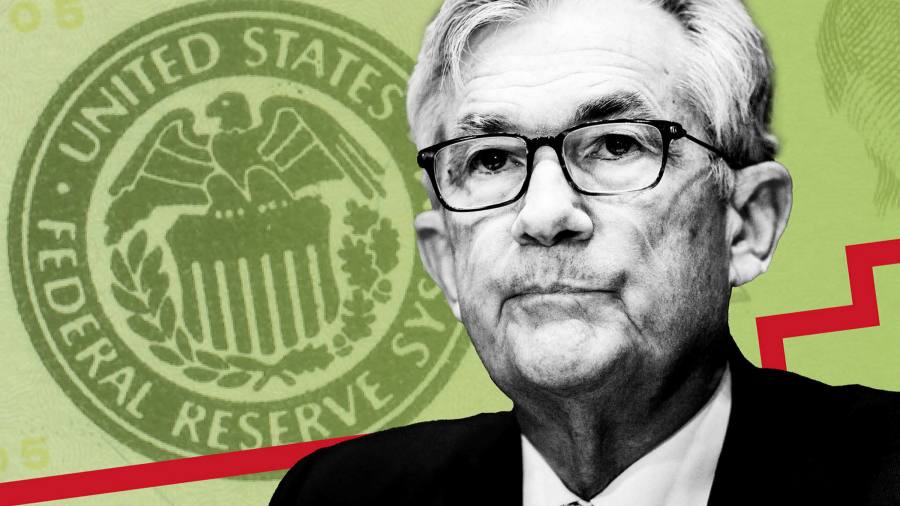Will the Fed shed light on its plans for later this year?
The Federal Reserve on Wednesday will conclude its two-day June policy meeting, at which it is widely expected to raise interest rates by half a percentage point. It will also release its summary of economic projections, which includes a so-called dot plot, showing members’ forecasts for interest rate policy.
At the Fed’s May meeting, chair Jay Powell said that if inflation and economic conditions remained broadly in line with the bank’s expectations “we would have 50 basis point increases on the table at the next two meetings,” meaning in June and July. But the chances of another supersized rise in September are unclear and will depend on how much of an effect the continuing aggressive hiking cycle has on inflation.
NatWest chief US economist Kevin Cummins expects the median dot — the average Fed official’s view for where interest rates will be by the end of the year — will have risen from 1.875 per cent, expressed in the March report, to 2.625 per cent. But he doesn’t expect it to rise much further from there in 2023 or 2024.
Inflation data for May — which showed that consumer prices had continued to rise, at a 1 per cent rate from the previous month and at an 8.6 per cent rate year over year — will probably add pressure to the Fed to aggressively pursue higher interest rates. The futures market on Friday morning in New York was betting that the Fed’s key interest rate would be at 3.1 per cent by year-end, versus 2.8 per cent at the start of the month. Kate Duguid
Will the Bank of England opt for an extra large rate rise?
A fifth interest rate rise in a row from the Bank of England is all but certain this week. But investors and economists are divided on how large it will be.
Market pricing indicates a further 0.25 percentage point increase to 1.25 per cent is the most likely outcome, with an outside chance that the BoE could follow the Federal Reserve in opting for an extra-large half point rise.
The dilemma for the BoE is how to tame inflation that soared to a 40-year high in April without choking off economic growth. For now, data showing strong wage growth, along with the government’s recent fiscal support for the economy, should mean that inflation concerns dominate, according to Bank of America’s UK economist Robert Wood.
Wood expects a quarter-point rate rise on Thursday but with three members of the BoE’s nine-strong rate-setting committee voting for a larger increase and the central bank shifting to more hawkish guidance for the remainder of the year.
However, with growth set to slow further, the “narrow path” the BoE can tread in battling rising prices without triggering a downturn may soon be set to disappear, according to Wood.
“We see increasing risks that the BoE has to choose between bringing inflation back to target or avoiding a recession,” he said.
The BoE’s previous rate increases have failed to offer much support to the pound, but that could change if the bank makes a more decisive hawkish shift this week, Bank of America said. Tommy Stubbington
Will the Bank of Japan say more about yen weakness?
The big question from next week’s Bank of Japan monetary policy meeting is not whether the central bank remains on hold. The overwhelming majority of economists are sure it will do so, intensifying the contrast with other central banks around the world which are now firmly in a tightening cycle.
This contrast is the main dynamic that has caused the yen to fall so sharply against the US dollar and other currencies in recent months, and has tipped the Japanese currency close to a 24-year low.
With the yen’s eye-catching tumble now looming over next week’s meeting, the focus will be on what Haruhiko Kuroda, the BoJ governor, says about the historically weak currency in his press conference after the policy decision is announced.
Speculation around Kuroda’s likely comments shifted on Friday after the BoJ, Ministry of Finance and Financial Services Agency released a rare joint statement aimed at “jawboning” some stability into the dollar-yen exchange rate by referring to concerns over the sharpness of recent moves.
But in a separate interview, Masato Kanda, vice minister of finance, said: “If asked whether a move of several yen in a single day is in line with fundamentals, I think many would say that’s not the case.” That comment, said analysts at Nomura, could raise pressure on Kuroda to state whether he is among those who see the recent moves in the yen as now shifting his view that a weak yen is of general benefit to the Japanese economy. Leo Lewis


